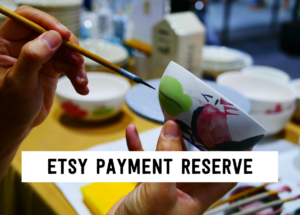
How to find the best Etsy keywords in 3 simple steps using Alura
If you want to be found in search results on Etsy, you need to optimize your product listing for SEO. And if you want to
join

FREE WORKBOOKS, CHEAT SHEETS, AND RESOURCES TO HELP YOU START, GROW AND PROFIT FROM YOUR HANDMADE SHOP.
There are 3 main handmade business models that we are going to consider today:
Each of these models is an opportunity to reach customers through a unique sale channel. Please keep in mind that nothing is set in stone here and that most businesses will end up being a mix of these. It’s all about finding the right balance.
Another way to sell your products is to focus on craft fairs, markets, and live events. Before the internet, this was the one and only way to sell and showcase handmade products to potential customers. Today, it still remains a very popular choice in the handmade industry.
Handmade buyers like to meet and talk to the seller, and craft fairs and markets offer the best way to interact with customers and introduce yourself. Although a great option, it can be difficult to scale. Having your own online shop on the side or selling your products on an online marketplace (such as Etsy) is a must if you want to generate more sales and have more room to grow.
If you don’t mind working on the weekends, this is a great option with a low entry cost to get started. Most markets charge a fixed stall cost so you know exactly what your expenses will be.
Selling your products online is the easiest way to reach a large number of customers, from the comfort of your own home. And nowadays, it’s kind of a must have too. Most handmade business owners selling their products at craft fairs and markets or through retail shops also have your own online shop these days. But you can decide to focus solely on selling online if you want to and there’s different ways you can do so.
The first is to sell your products on handmade marketplaces (such as Etsy, MadeIt, Folksy, Artfire, etc.). This is a good option to test out the waters as the set up cost is very low. You don’t need to invest in your own website and can be up and running in no time. Your products are also showcased to all the visitors of this marketplace, without you having to bring traffic to your page. Careful though, this means that you are in direct competition with thousands of other sellers selling on this marketplace, and you don’t “own” your space. This is problematic because you can’t create a strong relationship with your visitors or customers (through an email list for example), you are vulnerable to fee increases, and your shop could be closed without notice (although unlikely, it has happen to a fair few handmade sellers on Etsy! Simple type in “my Etsy shop got closed” on Google and see for yourself!)
The best way to sell your products online is through your own website. You can set up a shop really easily with no design skills thanks to the beautiful templates that both Woocommerce (wordpress) and Shopify provide and be up and running in no time. This requires more work and investment (in time or money) upfront but is by-far the best long-term plan as you are in control of every aspect of your sales channel and customer interactions.
For the sake of writing this article, I had to categorize the different handmade business models that exist and put things into boxes. Truth is, most successful handmade businesses mix and match these models to come up with what works best for them.
Eg.: If there’s a big craft market in your city the first sunday of each month, you could decide to sell your handmade soaps there for exposure and extra income but still have your products available online through Etsy and on your own website.
Eg.: You could sell handmade knitted socks for kids to a few kids clothing stores in your town and also have a online shop on your own website.
The possibilities are endless, and the only way to figure out what will work best for your is to:
1 – Ask yourself if the model you’re creating for your business is sustainable from a personal point of view (eg.: “Do I want to be working every weekend?” “Will I mind having to create in bulk when I receive a large order?” etc.);
2 – Ask yourself where your ideal customers hang out and buy (online or offline? Which shops? Which websites? etc.) and be where they are;
3 – Ask yourself if this model will work for the type of products you are making (if you’re selling items that have a low profit margin, you need to consider a model that will allow you to scale and sell in larger quantities: selling on markets only might not be suitable in this case).
you might also like…
related articles

If you want to be found in search results on Etsy, you need to optimize your product listing for SEO. And if you want to

There has been a lot of talk in the Etsy community — and I mean A LOT of talk — about Etsy’s payment account reserve

Anyone who knows me knows that I am a HUGE advocate for using email marketing to grow and scale your handmade business. But you may
Sign up below and get instant access to a collection of FREE practical guides, workbooks, and checklists that will help you start, grow and profit from your handmade shop. (without pulling your hair out!).
disclaimer
subscribe to youtube
become a member
get in touch
We acknowledge and give thanks to the Budawang and Yuin people, the Traditional Owners of the land we work and live on. We pay our respects to all Aboriginal and Torres Strait Islander Peoples and elders past, present and emerging.
4-step Maker’s Roadmap System
Library of In-Depth Courses and Training
Live Monthly Coaching Sessions
A Supportive Online Community
close
We hate spam too. Unsubscribe at any time.
close
We hate spam too. Unsubscribe at any time.
close
We hate spam too. Unsubscribe at any time.

Get Instant Access to
The FULL Resource library